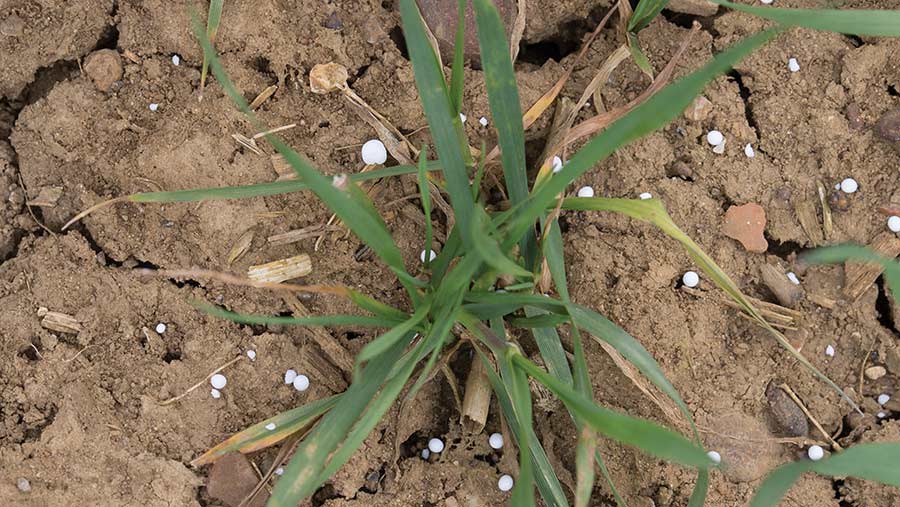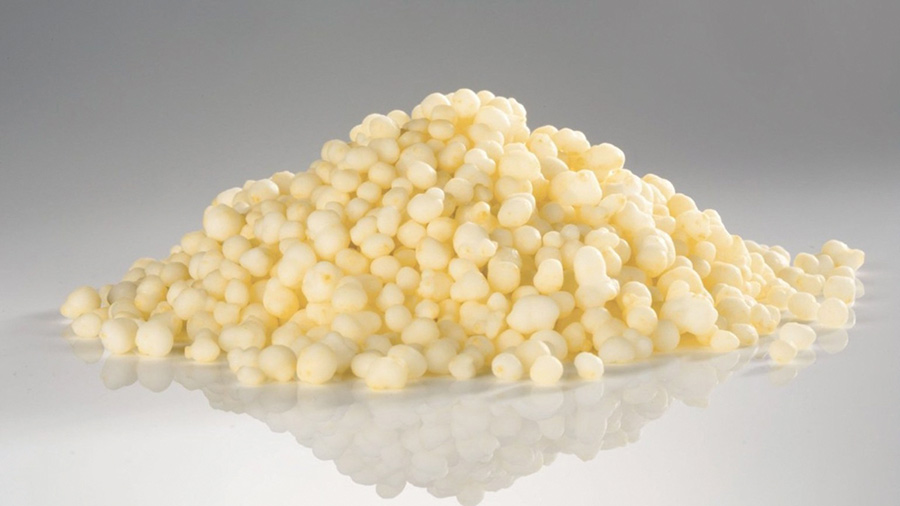How treated urea is helping farming company to improve NUE
 © GNP
© GNP New rules mean farmers can only use standard urea up to 31 March, but Velcourt is going a step further by only using urea fertiliser treated with an urease inhibitor.
This move is on the back of two seasons of trial results, as the company looks to improve its fertiliser use efficiency.
See also: Herbal leys help halve nitrogen fertiliser use for wheat
Velcourt’s head of crop technology, Nick Anderson, explains that nitrogen (N) fertiliser is the largest direct cost in its arable farming operations.
The company measures nitrogen use efficiency (NUE) on its farms, and in 2023, the company average was 55%, but there was a range of 44% between the highest and lowest.
Even taking the 55% figure into account, that means 45% of the product was not used by crops, he says. And there is an environmental impact of these nitrogen losses.
Therefore, Nick says there is an environmental and economic imperative to do better with nitrogen utilisation by crops.
He believes this can be achieved by using the right product at the right place at the right time, as part of an integrated nutrition strategy.
Urease inhibitors
One element of the company’s integrated approach (see box: “Integrated approach to nutrients”) is the use of urease inhibitors when applying urea.
This year sees the implementation of new fertiliser rules, where standard urea can only be applied up to 31 March.
After that, only urea treated with an urease inhibitor can be applied.
However, Velcourt has decided to no longer use standard urea on its farms, instead opting for Limus-treated product.
He points out that volatilsation can occur before 1 April, as some days in March can have warm, breezy conditions.
“As a business, where there is a risk of ammonia losses with urea, we will only use treated urea. This is best for farm margins as well as the environment.”
The farms also use ammonium nitrate, but as the Limus-treated product has a higher nitrogen content (46% versus 34.5%), it means they can still enjoy the benefits of using urea. For example, increased work rates and less storage space.
And by dropping standard urea, storage is kept simple with two solid products.
Before adopting the technology, on-farm trials were carried out. They first looked at whether there were benefits with a urease inhibitor, recalls Nick.
When using Limus-treated urea, they saw an increase in efficiency with N use compared with untreated urea.
They then compared it with ammonium nitrate. Over two years, Limus-treated urea performed at least as well as ammonium nitrate.

Ammonia loss on dry soil with standard urea © Tim Scrivener
On-farm experience
Adrian Whitehead, who manages six farms for Velcourt, near Kings Lynn, says the landowners are taking an increasing interest in the environment.
His average NUE is 65%, so it is already ahead of the curve, and he says all his fertiliser decisions are based on data.
The first application in a season is a liquid nitrogen + sulphur mix, as he likes to get the sulphur on early.
“The sprayer isn’t too busy then, so fits nicely with the workload.”
The rest is applied as solid fertiliser in two splits. The first is Limus-treated urea, followed by ammonium nitrate.
Adrian says having just one urea product keeps storage simple.
He routinely gets his Amazone spreader tested by SCS, and results show good spreadability at 36m tramline widths for the urea product.
Nitram is the industry standard and it was similar with less than 10% co-efficient of variation.
Looking ahead, both Nick and Adrian see a greater use of treated urea on Velcourt farms, with ammonium nitrate reserved for more marginal conditions, such as windy periods.
“You can cover a lot more acres in a day, so [urea] is more efficient,” says Adrian.
Integrated approach to nutrients
Nick Anderson says their approach starts with gaining accurate estimates of soil nitrogen supply (SNS). “This is measuring what’s in soil.”
It’s a combination of the field assessment method and soil mineral nitrogen plus (SMN plus), which also estimates N that will become available through mineralisation during the growing season.
On the other side is assessing crop requirements, and this is based on historic field performance and crop condition.
Velcourt is also carrying out harvest analysis of grain to check if they are getting it right.
“If levels are high, then we are oversupplying N or yield was limited. If levels are too low, then we have undersupplied or there has been has been a constraint on recovery,” he says.
Accurate spreading is important and spreaders are tested each season for each product.
Finally, the company uses the best available technology and trials are being carried out to monitor this.
Technology being tested includes novel forms of N, remote sensing of fields, nitrification and urease inhibitors plus endophytes (bacteria that colonise leaves and fix nitrogen).
Integrated approach
- Accurate determination of what is in soil and crop requirement
- Timely application and appropriate splitting
- Accurate spreading
- Use of best available technology trialled on Velcourt farms, such as Limus-treated urea
What is Limus?
Urease inhibitors slow down the conversion of urea to ammonium, thereby reducing ammonia losses to the atmosphere.
As BASF’s business development manager for Limus Jared Bonner explains, urea fertiliser needs to be broken down into ammonium (hydrolysis) to be plant available.
This is carried out by naturally occurring urease enzymes.
However, in certain conditions, this can occur too rapidly, leading to losses of nitrogen of up to 20% as ammonia.
He says using the urease inhibitor Limus reduces these losses by up to 98% in the lab and by 50-70% in the field.

Limus-treated urea © BASF
So how is ammonia lost when using urea?
Urea granules are hygroscopic, absorbing moisture from the air. Once applied, urea starts to move into the soil.
Urease enzymes start the hydrolysis process, releasing ammonium, which is alkaline. This temporarily raises soil pH around the granule.
If the urea is not washed into the soil by rain to buffer the pH spike, ammonia starts to be volatilised.
The inhibitor binds with the urease enzyme so that it can’t bind with the urea, slowing down hydrolysis.
Once in the soil, it is swamped by the urease naturally present. In addition, the inhibitor is broken down in two to three weeks.
“Effectively, its stopping hydrolysis on the soil surface, but not once in the soil.”
Jared adds that Limus is unique in being the only product containing two different inhibitors – NPPT (N-(n-propyl) thiophosphoric triamide) and NBPT (N-(n-butyl) thiophosphoric triamide).
It’s also the only product containing NPPT, which, unlike other inhibitors, lasts 12 months. This means farmers can carry stock over into the next season.
He points to BASF trials showing that Limus-protected urea generated crop yields as good as those with ammonium nitrate. “It isn’t a second-best fertiliser,” says Jared.
By using treated urea, farmers can increase their NUE. This enables them to reduce N input costs, thereby improve their margins, he says.
Limus-treated urea is available from Cofco, Thomas Bell and Bartholomews. There is also a version, called Limus Perform, for farmers using liquid urea.

